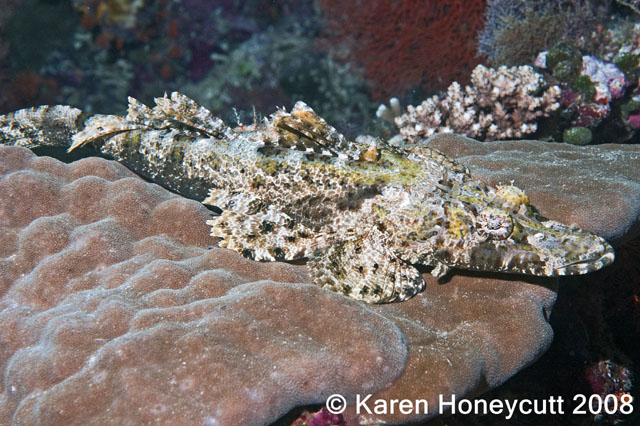| Platycephalidae (Flatheads) |
| 50 cm TL (male/unsexed) |
|
reef-associated; marine; depth range 1 - 12 m, non-migratory |
| Western Pacific: Philippines, Borneo, Moluccas, Papua New Guinea, New Caledonia, Palau, and Yap Island to Ishigaki Island. Range extended to Mentawai Islands (Indonesia). |
|
Dorsal spines (total): 9-10; Dorsal soft rays (total): 11-11; Anal spines: 0-0; Anal soft rays: 11-11. Small juveniles all black, gradually changing to the blotched pattern of the adult (Ref. 48635). Rear edge of maxilla ends well in front of eye. Prominent pit present behind upper eye. Preopercular spines short, usually 2, subequal. Infraorbital ridge usually smooth over eye. Suborbital ridge largely smooth, bearing 2 spines below eye. Oblique scale rows slanting backward above lateral line more or less equals number of lateral-line scales. Dermal papillae (10-12 in adults) on upper eye, some simple, some branched, longest not reaching supraorbital ridge. Interopercular flap usually broader than long, with several subdivisions.
Description: Characterized by having 1-3 anterior lateral line scales with small weak spine; absence of preorbital spines; cirrose iris lappet (Ref. 90102). |
| Lives on sand or rubble substrates of sheltered or semi-exposed reefs to a depth of at least 8 m (Ref. 9710). Well camouflaged on reefs (Ref. 48635). Also found in coral reefs and mangrove area in about 1-12 m (Ref 90102). |
|
Least Concern (LC); Date assessed: 04 March 2015 Ref. (130435)
|
| harmless |
Source and more info: www.fishbase.org. For personal, classroom, and other internal use only. Not for publication.
